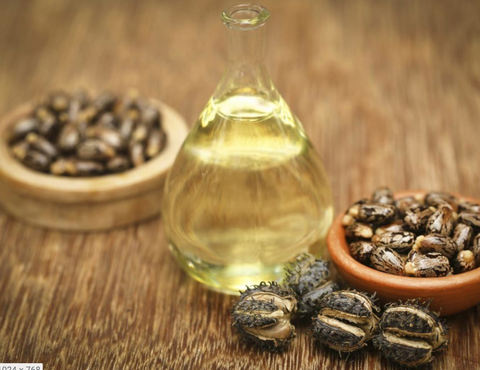Benefits of Castor Oil
What are the benefits of castor oil?
Castor oil comes from castor beans (the seeds) of the Ricinus communis plant. This oil has been used for thousands of years as a laxative (well established) and to induce labor (not so well established) when taken by mouth. It has also been credited with many healing qualities when used on the skin such as decreasing inflammation and pain and to have antimicrobial properties. In fact, castor oil’s antibacterial and antifungal properties have led it to be used to coat grain to prevent rotting.
What are the beauty and skin care benefits of castor oil?
The castor oil is unusually high in ricinoleic acid, which technically speaking is an unsaturated omega-9 fatty acid with a hydroxyl group on the 12th carbon. This unique chemical structure causes the oil to be both hydrophilic (water loving) and lipophilic (fat loving) allowing much better penetration into the skin than other vegetables oils. This translates to benefits for the skin. Studies show castor oil is a powerful emollient (moisturizer) and protectant. It is able to prevent water loss ands promotes the healing process in the skin. It also has anti-inflammatory properties to settle redness and swelling after injury in the skin and antifungal properties (it inhibits the growth of yeast).
How should you use castor oil and how can you incorporate it into your skin, hair, and body regimen (on its own or in products)?
For your skin, lips and cuticles, look for castor oil as an ingredient in products made to hydrate and soothe. Because of the many wonderful qualities of this vegetable oil, I decided to use it as the main ingredient in my healing balm (Doctor Rogers Restore Healing Balm). However, I balanced its undesirable characteristics with plant derived glycerin and castor wax. The end result is amazing and what many dermatologist use in their offices to aid in skin healing.
In fact, Restore Healing Balm benefits were recently confirmed in a blinded, comparative study of healing after CO2 laser procedures. Treated patients were given Restore Healing Balm for half their face and Aquaphor for the other. The Restore Healing Balm side outperformed the Aquaphor side in every measure (speed of healing of red, swelling and crusting.) This study was published in the Journal of Drugs in Dermatology and presented at American Society for Dermatology Surgery Annual Meeting in 2018.
Do I need to be worried about Ricin in castor seed oil?
The ricin in castor seeds is only in the shells of the seeds. The seeds are crushed to extract castor oil and as ricin is not oil-soluble, little to none is found in the extracted castor oil. But to be safe the extracted oil is then heated to more than 80°C to denature any ricin that could be present. You do not need to worry about ricin contamination in any of our products. Only the highest grade castor oil, per the International Castor Oil Association (ICOA) industry specifications, are used in Restore Healing Balm. Further, the castor oil used to manufacture Restore is obtained by hydraulic pressing of the castor beans. No solvents are used to extract the oil.

What are some precautions or dos/don'ts to consider with castor oil?
Despite all its benefits, castor oil is not easy to work with. It has an unfortunate smell, a thick, greasy texture and is hard to use on the skin as a stand-alone ingredient because it is so messy. As it is an oil, if you get it on your clothes or bedding it is difficult to get out. (BUT because of its polar structure, it is easier to remove than other oils. Try rubbing alcohol or an alcohol based stain remover for the best results!)
Pure castor oil is great for the hair as the fatty acids condition and increase its shine. It may even promote hair growth (although that has not been studied). It is also a very effective laxative. But don’t drink much or you will regret it. In fact, drinking castor oil was used as a punishment for political dissents in fascist Italy!
References:
- Vieira C1, Fetzer S, Sauer SK, Evangelista S, Averbeck B, Kress M, Reeh PW, Cirillo R, Lippi A, Maggi CA, Manzini S. Pro- and anti-inflammatory actions of ricinoleic acid: similarities and differences with capsaicin. Naunyn Schmiedebergs Arch Pharmacol. 2001 Aug;364(2):87-95.
- https://www.ncbi.nlm.nih.gov/pubmed/23438045
- https://www.ncbi.nlm.nih.gov/pmc/articles/PMC1781768/
- Chang YC, Croix J, Hernandez S, Chapas A. A Comparative Split-Face Trial of Plant-Based Hypoallergenic Ointment vs Petroleum-Based Ointment Following Fractionated Carbon Dioxide Laser Resurfacing of the Face. J Drugs Dermatol. 2018 Nov 1;17(11):1178 - 1182.
All product recommendations on this site are not sponsored and reflect the independent opinion of Dr. Heather D. Rogers, MD, based on her evidence-based research and extensive clinical experience as a practicing dermatologist. Links are provided for your convenience. Some may include discounts or commissions. Please shop wherever works best for you.
To receive expert, educational skincare insights from Dr. Rogers each week, sign up HERE.
The content on doctorrogers.com and our social media channels - including articles, blogs, videos, newsletters, and linked resources - is intended for general educational purposes only. It does not constitute medical advice, establish a doctor-patient relationship, or replace consultation with your physician. Use of this information and any recommended products is at your own risk and signifies your agreement with our Terms and Conditions. Nothing shared is intended to diagnose or treat specific medical practice.

